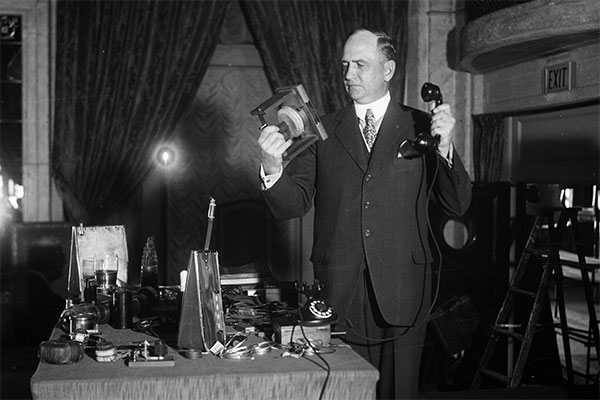Invented by Law: Alexander Graham Bell and the Patent That Changed America
Christopher Beauchamp
Harvard University Press, $42 (cloth)
One hundred years after the signing of the Declaration of Independence, Alexander Graham Bell’s nascent telephone caught the attention of an admiring world at the Centennial International Exhibition in Philadelphia. “In felicity and fecundity of invention,” the London Times reported, “in audacity of enterprise and persevering energy, the Americans show themselves . . . among the foremost, if not the first.”
Bell’s patent, secured just months earlier on March 7, 1876, looms large in the story of the United States’s growth as a technological superpower. Arguably it is rivalled in celebrity and profitability only by Thomas Edison’s patent for incandescent light, granted a few years later. So remarkable were these displays of American innovation that lingering European doubts about the value of patent systems soon faded. The Bell telephone, together with the laws that vouchsafed its inventor’s rights, would set the economic and legal standards for the rest of the world to follow.
This triumphalist narrative powers many sympathetic biographies of Bell, such as Robert V. Bruce’s Bell: Alexander Graham Bell and The Conquest of Solitude (1973), which portrays a heroic inventor struggling to secure just rewards. Over the years, however, the cozy glow of such fables has been darkened by suspicions of fraud, such as those detailed most recently in Seth Shulman’s The Telephone Gambit: Chasing Alexander Graham Bell’s Secret (2008). There is evidence that Bell bribed a Patent Office official to steal key ideas from his Midwestern rival Elisha Gray, but these claims remain controversial, in part because Bell’s lawyers bought Gray’s silence.
Legal historian Christopher Beauchamp’s new book Invented by Law: Alexander Graham Bell and the Patent That Changed America enlarges our understanding of the Bell legacy by inviting us to step back from the myths and the moralizing, the hero worship and the scandal mongering. Though inventors became celebrities in industrializing America, it was not individual ingenuity but the legal wizardry of patents—and the shrewd, increasingly influential lawyers who secured them—that most powerfully shaped technology, the economy, and society. Beauchamp uses the story of the lawyers who made Bell the inventor of the telephone to show how the patent became a key weapon of market power and the cornerstone of a new legal-industrial complex.
The book takes a longue durée approach, going back as far as 1790—more than a half-century before Bell was born—when the young nation’s legislators were deliberating over a new body of patent law.
These lawmakers saw little to preserve in their colonial inheritance, which treated patent rights as a monopoly privilege endowed exclusively by the British monarch. Instead of focusing on the state’s economic needs, the Americans prioritized the rights of individual inventors. In 1790 they produced the country’s first patent law, granting “true and first” inventors a form of property rights as a reward for their labor, time, and money—but on the condition that the inventions were “sufficiently useful and important.” This was a striking departure from unpragmatic British patent law, which ignored utility.
But what legal mechanism would adjudicate an inventor’s claims to priority? To answer that question, Beauchamp takes us through the evolution of the U.S. patent system and the tremendous amount of litigation it spawned. In part due to the high level of scrutiny with which applications were initially assessed, the 1790 law was replaced two years later by a more accepting system; patents were simply registered without being examined for novelty or utility. As a result disagreements took to the courts, where they were vigorously pursued. By 1809 the State Department administrator overseeing the registration system would insist that “many of the patents are useless, except to give work to the lawyers, and others so useless in construction as to be . . . merely intended for sale.” Others complained about the many “frivolous, absurd, and fraudulent” patents taking up judges’ time.
Those who argue for the necessity of patents will not find support in the telephone.
In the face of such criticism, the U.S. Patent Office was founded in 1836 as an official site to ascertain novelty and utility. Emboldened by a fresh certainty in the robustness of their rights, inventors pursued formal infringement proceedings to reap the fullest financial rewards of widely used technology. Lawyers who had already acquired a key role in litigating priority disputes in the 1790s now found themselves permanently indispensable.
By the end of the Civil War, a tradition had begun to take shape, one that would only grow as the century drew to a close. Over 600,000 patents were issued between 1865 and 1900, more than ten times the number issued before the war and more than twice as many as any other country had granted in the same period. The extent of litigation rose proportionately. Business owners sought exclusive patent rights to secure monopolies; their lawyers oversaw the terms, managed permissions, and sued infringers. By ruthless enforcement, innovators and their lawyers profited greatly from waves of new technology: mechanical reapers in the 1830s, vulcanized rubber and the electric telegraph in the 1840s, sewing machines in the 1850s. While the patent system helped many humble inventors and independent craftsmen to secure protection for their work, it also garnered for lawyers a comfortable income and an enormous influence in the business world. Without effective counsel to assert and defend patent rights within the seventeen years before they expired, an inventor would struggle to win investors, and all hopes of profitability might be in vain.
Thus it was that in 1875 a twenty-eight-year-old Bell—having left London for Canada in 1870 and arrived in Boston only in 1871—found himself seeking the advice of patent attorneys in navigating the unfamiliar and evolving terrain of U.S. patent law. He hired the redoubtable Chauncey Smith as general counsel. In two decades of courtroom drama, Smith and his fellow patent attorneys emerged as the central figures in the early story of the telephone. The legal defense not only secured Bell’s patent but also helped, more fundamentally, to define what such a document meant.
The central issue debated in the courts was who exactly invented the telephone. The framing of this question derived from an Anglo-American legal tradition dating back to 1624, which presumed that there must be a unique—“true and first”—inventor, even if the common-sense facts of the matter indicated, to the contrary, that an invention had many parents in many lands. It was legal rules, not workshop lore, that defined the terms of this inquiry.
Complicating matters was the fact that the telephone was not exactly what Bell had set out to invent. He had worked with a group of entrepreneurs to improve methods of telegraphy using sound-based electrical signals, but the resulting development of profitable speech transmission was neither inevitable nor Bell’s sole doing. Indeed, in 1876, when Bell won his patent, the telephone was barely more than a protean experiment, in need of significant refinement before it reached the market in 1878. In fact, it was not until nearly a month after his lawyer submitted his patent that Bell successfully transmitted intelligible speech. Thus Beauchamp’s careful contention that the telephone emerged from a “high-tech start-up whose strategies were driven by investor relations and the exploitation of patents.” The notion that Bell himself was primarily responsible for the invention only arose in the legal proceedings. “The glorification of Alexander Graham Bell,” Beauchamp says, “began as an imperative of litigation.”
Bell’s lawyers, who brought around 600 infringement cases, tailored an interpretation of his patent to suit standards of legal proof and maximize the scope of his claims—an interpretation often at odds with Bell’s own. It was not Bell but his lawyers, Beauchamp stresses, who “prepared the contending positions, marshaled evidence, and argued publicly and bitterly over the origins and nature of the technology.” Striking in this regard is an 1879 letter Beauchamp quotes in which Bell complains to his wife Mabel:
Chauncey Smith and Company . . . dissecting my patents for the purpose of deciding what valid claims there may be on which to base an argument tomorrow. Oh! My beautiful patent of 1876! My specification of which I was so proud! They have hacked it to pieces—They have torn it limb from limb—They have plucked out the heart of the invention and have thrown it away—They have cast aside as useless all that I thought most valuable. They have subjected my invention to hydraulic pressure from legal minds and have squeezed out into the gutter—the very life-blood of the idea. All that remains of my poor specification is—a little dry dust—which they blow in my face as the essence of the speaking Telephone! It is in vain that I protest. ‘An inventor is the worst judge of his own case’—‘A man should never prune his own fruit-trees’ and similar sayings—are rammed down my throat—ad nauseam—until I am choked into submission.
Beauchamp’s title—Invented by Law—is thus to be taken literally: it was the practice of law that defined the identity and status of the telephone as a novel invention and crafted a patent robust enough to survive courtroom challenges.
And challenges there were. Bell had not been alone, after all, in experimenting with the aural possibilities of the electrical telegraph. Besides Gray, Daniel Drawbaugh, Amos Dolbear, Peter Dowd, Antonio Meucci, and others defended rival claims to priority. Each did so as the star witness for anti-Bell lobbies that funded and facilitated their courtroom appearances. In an unprecedented move, even the U.S. government took on Bell’s patent in court, alleging fraud. These challengers exemplified larger moral and financial concerns about the long-term economic consequences of monopoly power achieved through a broad construal of corporate-owned patent rights. Those concerns also played out in Congress, which tried, but failed, to pass anti-patent legislation throughout the 1880s.
The courtroom challenges failed, too. Under cross-examination by Smith and his team, the anti-Bell witnesses failed to persuade the court of their priority. Unable to find a living American to undermine Bell’s claims, both corporations and the government had one final courtroom recourse: the work of the late German schoolteacher Phillip Reis, who in the early 1860s constructed a device he called the telephon. Smith and friends made much of this device’s limits: it could reproduce music travelling from a remote source, but it could not reliably convey intelligible speech. When United States v. American Bell Telephone Company finally came to the Supreme Court in 1888, the company won by a four-to-three vote. This slim margin showed just how controversial Bell’s claims were, but the company’s dexterous and well-paid legal team succeeded in vindicating the monopoly of what was already a hundred-million-dollar company.
The long-term significance of the verdict was monumental. The Bell monopoly became one of industrial world’s most lucrative patent-based companies. In America, none earned better. The Bell company signaled the rise of a great new corporate power that used the full force of law to ruthlessly eliminate direct competition. The early patent legislators surely had not planned for this outcome when they laid out the generous and easygoing terms of the 1793 patent law. The unforeseen rise of the legal profession, especially its patent division, enabled a single patentee to control a vast part of the country’s infrastructure, with lawyers quietly benefiting from the attendant prestige, power, and income. It was not until the 1910s that the Supreme Court moved in the public interest to allow antitrust legislation that limited the conduct of patent pools, the collective licensing among different patent holders that had enabled the formation and long livelihood of consolidated monopolies, including Bell’s.
Beauchamp wryly observes that although the Bell litigation was among the largest courtroom conflicts of the nineteenth century, one would hardly get that sense from a standard legal or economic history of the period. One reason he offers is that “a reputation for inaccessibility, professional specialization, and narrowly fact-specific court rulings . . . have functioned to distance patent law from the historical mainstream.” But there is also the implication that the legal profession does not recognize its conduct in this period as a shining example of good practice. This bitterly controversial and embarrassingly all-consuming patent dispute won no new insights for jurisprudence, and many reputations were lost in the process. While the practice of robust litigation became ever more lucratively entrenched the courts, this vexatious episode was so little cherished by the profession that it is practically invisible in today’s law books.
Beauchamp notes too that the history of the telephone played out differently abroad, especially in Germany. There had been significant doubts across Europe about both the public benefit and industrial necessity of patents. In July 1877, Germany finally introduced patent legislation, but before Bell’s lawyers could obtain rights, the technical press had already circulated designs of the telephone, rendering it part of the public domain. Thus Germany saw the productive development of diverse telephonic equipment under conditions of open competition, without patent rights restricting the innovating activities of Bell’s rivals, such as Siemens. Even within the United States, the railroad industry had seen vigorous growth without using patents to underwrite single-company monopolies. Those who would argue for the economic necessity of patenting will not find support in either the telephone or the railroad, two key inventions in America’s growth to industrial supremacy.
Individual patentees are no longer celebrated as Bell was; patenting has become depersonalized. But as Stathis Arapostathis and I argue in our 2013 book Patently Contestable, patent disputes are still at the heart of the telecommunications industry, just as they were in Bell’s time. Global corporations such as Apple and Samsung fight international patent battles to maintain brand power over successive generations of smartphones, and their lawyers continue to bring infringement suits to determine which company has the right to profit from which kind of innovation. Today, as before, law, not tinkering, determines what an invention is and who brought it to be.
Patent law is bounded, of course, by the desires of engineers, inventors, and their employers. Lawyers have not managed the fate of every technological advance, even within the telecommunications industry, because some inventors do not seek patents. For example, the Internet as a whole has never been the subject of a courtroom patent contest because it was developed in government labs as a response to the military contingencies of the Cold War. No lawyers took part when ARPANET merged with other networks to become the civilian Internet. And when the British physicist Tim Berners-Lee decided in 1989 to develop a new protocol—the World Wide Web—to share his research resources globally, he chose to make it a free, unpatented gift to all.
But it is surely a measure of the power of patent law that we must turn to the military or the altruism of state-funded researchers for examples of inventions that have escaped its influence. In his 1973 classic The Americans: The Democratic Experience, Daniel Boorstin quipped that the importance of any transformation in American life “could roughly be measured by the quantity of lawyerly energies which it called forth.” It is thanks in part to those energies chronicled in Beauchamp’s book that law’s invention of both objects and inventors has come to be taken for granted.








